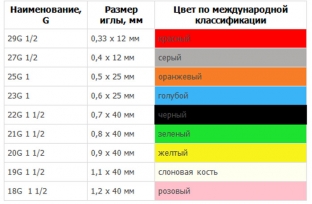Properly selected needles for injection during a cosmetic procedure not only help to inject the drug to the desired depth and according to a given pattern, but also give the cosmetologist self-confidence. By choosing the right needle, the injection procedure becomes more pleasant for the patient, because it causes less pain, and the risk of bruising and other side effects is also reduced. The modern medical industry produces a wide range of injection needles, and it can be difficult for a doctor to navigate new markings. Let's try to deal with them on estet-portal.com.
Choose the size: length and diameter of the injection needle
The variety of medical needles for injections is explained by their different purposes: for example, needles for injections into the skin, under the skin, intramuscularly and intravenously are most often used.
The length of the injection needle determines where the drug will be delivered. If it is intended to inject the drug into the muscle, then it must be of sufficient length to pass through the skin and underlying fatty tissues. When intradermal injections are contemplated, the length of the needle may be kept to a minimum. Commonly used injection needles are 12 to 70 mm long. Needles 40 mm long are suitable for intravenous injections, for intramuscular – 30-40 mm, for subcutaneous – 16 mm.
The diameter of the injection needle varies from 0.4 to 1.2 mm. This parameter affects how quickly the liquid will flow out of the syringe. In addition, the smaller the diameter of the needle, the smaller the puncture area and, accordingly, the lower the pain for the patient. But at the same time, liquid through a small diameter hole will take longer to flow, and therefore, when injecting a large volume of drug, this is not the best choice.
Injection needles may vary in cut type, wall thickness – each of the parameters must be considered when choosing a cosmetic procedure.
Colour solution: marking of the bases at the injection needle
The plastic base of the injection needle is usually of one color or another, which complies with international encoding rules. Many cosmetologists remember that, say, needles with a blue base are thinner than "green" ones. But in order to accurately select the right injection needle, you need to know their color matches:
Injection needle designations

All manufacturers of medical needles are required to code them in accordance with the international ISO system, where, in addition to the color features of the base of the injection needle, the concept of gauge (G) is mentioned to indicate its caliber. This parameter is calculated based on the length of the needle in inches, the thickness of its walls, and the inner diameter. The smaller the G value, the larger the inner diameter of the needle.
|
Needle: Gauge |
Standard application |
|
27G - 30G |
for insulin and tuberculin syringes, subcutaneous injections, paravertebral blockades, in mesotherapy, dentistry, |
|
25G |
for insulin and tuberculin syringes, subcutaneous injections, paravertebral blockades, intramuscular injections for children, in dentistry, |
|
22G - 23G |
for intramuscular injections and for droppers |
|
19G - 21G |
for intravenous injections, blood sampling, for taking the drug from an ampoule/vial, |
|
for intravenous injections, |
Due to the variety of injection needles, the cosmetologist has the opportunity to choose instruments in accordance with the upcoming procedure, taking into account the patient's skin condition and age, the viscosity of the drug being injected, the number and frequency of the intended injections, and carry out the procedure with maximum comfort for the patient.







Add a comment